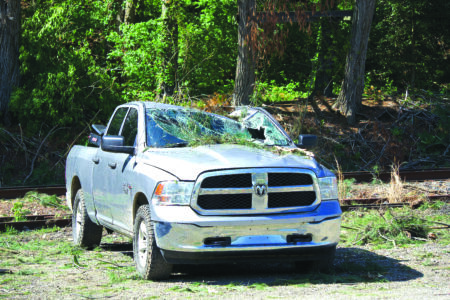Spotted lanternfly return has W.Va on alert

File Photo The spotted lanternfly has been found in several areas of West Virginia, including the Northern Panhandle.
A small black bug with white spots will soon be spotted on plants and trees in several areas of West Virginia, including the Northern Panhandle, as the spotted lanternfly is returning to the Mountain State for the summer.
The spotted lanternfly is an invasive insect native to Asia that moved to Ohio and Marshall counties from Ohio and Pennsylvania beginning in the late summer of 2023, according to Spotted Lanternfly Program Coordinator for the West Virginia Department of Agriculture James Watson.
The insect has been found in the state’s Northern and Eastern panhandles, as well as Monongalia County, as the bug’s eggs hatch in late April. At this early stage of development, the bug has a small body with white spots.
Watson said residents will begin to see the larger adult form of the bug with red and black spots beginning in July. The bug will remain in the area until several hard freezes occur in the winter.
“The spotted lanternfly is very small when they hatch out,” Watson said. “They’ll be fairly small for several weeks to a couple of months, and then change color to red and be a little bit larger in July. When they change color, they become more conspicuous, and people will start to see them and notice their swarms.”
The spotted lanternfly is commonly seen on the invasive tree of heaven species, its preferred host. The bug also feeds on several secondary hosts, including grapes, hops, silver maples, red maples, black walnuts, sumacs and Virginia creepers.
Waton said any county in the state with a sizable population of tree of heaven will develop spotted lanternfly populations. Though the insect will soon be hatching in the Northern and Eastern panhandles, the spotted lanternfly arrived in these parts of the state through different means.
The Northern Panhandle population of the insect stems from offshoots of larger infestations in Pennsylvania and Ohio that move to the area from there. Watson said there were sizable populations of the bug in Brooke, Hancock and Ohio counties, with Marshall County being the only area without a sizable population.
The Northern Panhandle has one satellite population of the insect in Weirton. A satellite population is not connected geographically to a larger infestation and has uninfested areas surrounding it.
In contrast, Watson said the Eastern Panhandle is “heavily infested,” with multiple spotted lanternfly satellite populations in the area. Berkeley, Jefferson, Morgan and Mineral counties all have large, widespread spotted lanternfly populations. Hampshire County has pockets that do not have large populations of the bug, and the insect’s growth is “just getting started” in Grant and Hardy counties.
As the spotted lanternfly population grows in the state, Watson said the insect will threaten agriculture and forestry due to the increased feeding pressure on secondary food sources of the bug.
“The bottom line is the tree of heaven is the spotted lanternfly’s preferred host, and having more tree of heaven boosts their population because it gives them the nutrients and substance they need,” Watson said. “More tree of heaven means more spotted lanternfly, which will increase feeding pressure of secondary hosts.”
Watson said grapes and hops are of particular concern in terms of agriculture. Regarding forestry, the insect particularly threatens maples and black walnuts.
Local farmer Eric Blend, who co-owns the Blended Homestead in the Oglebay and West Liberty area, said farmers are considering which crops they will plant now because of the insect.
“Sometimes people just think, ‘Oh, it’s a bug flying around,’ but because of the spotted lanternfly, we’re not planting grapevines,” Blend said. “Your decision-making as a farmer can change based on the bug.”
The main way to curb the insect’s spread is to remove the tree of heaven plant from one’s property. Watson recommends cutting the plant down in July through November and applying herbicides to the freshly cut stump.
“People should absolutely kill any spotted lanternflies they see, but removing their primary food source will create a longer, lasting impact,” Watson noted. “Starving them out by removing the tree of heaven will produce better results than any of us are humanly capable of killing them.”
To identify a tree of heaven, Watson said a method that “will not fail regardless of the time of year or season” is that parts of the tree give off a “really bad odor” when they are broken off.
“Whether it’s a root, foliage or twig, the tree of heaven gives off a really bad odor, people have compared it to old peanut butter,” Watson said. “If there’s a question of whether it’s a tree of heaven, people just have to check whether it smells like old peanut butter. If it doesn’t smell like that, it’s probably not one.”
Watson also encourages residents to pay “very close attention” to any hitch-hiking spotted lanternflies on objects and vehicles to prevent the bug from spreading from infested to uninfested areas as people bring the insect with them as they travel.
Blend follows Cornell University’s College of Agriculture and Life Sciences’ recommendations for controlling the spotted lanternfly population in the area. These recommendations include setting sticky band traps to catch the insect on trees and even using a vacuum cleaner to suck the insect off of trees and plants.
Before the population matures, Blend advises residents to keep an eye out for egg masses and destroy them. Egg masses can be killed by burning them or putting them in a sealed bag to let them die.
Blend plans to use the invasive insect to his advantage, as he wants to train his chickens to eat the bug.
As a beekeeper, Blend is also excited about the possibility of spotted lanternflies in the area producing excess sugar water called “honeydew,” which creates a smoky flavor in honey when bees consume it.
“I can’t imagine the spotted lanternfly population getting to the point where we have enough that I’ll be able to pick it up through my honey bees,” Blend said. “If my bees make honey with the honeydew, it supposedly has a smoky flavor.”
Areas of Eastern Pennsylvania that have been infested with the bug since 2014 have seen the population decline after “several years,” according to Watson. He noted that it was unknown at this time whether the spotted lanternfly population in eastern Pennsylvania would eventually bounce back to higher levels in the area.
“We don’t know for sure yet, but it does seem like after several years, there is a decline in the number of spotted lanternflies in an area,” Watson said. “We’re hoping that some of the Eastern Panhandle counties are close to seeing that population start to decline, but it’s still unclear whether or not that’s long-term or if the population just cycles and comes back.”




